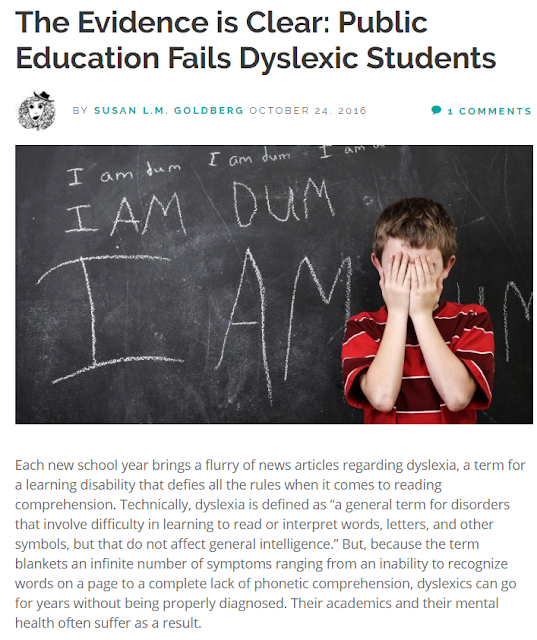US Public Schools Fail Students with Disabilities
The headline on PJ Media Parenting maybe harsh, "The Evidence is Clear: Public Education Fails Dyslexic Students". Sadly, the truth is that public schools over the past decade in the United States have not been able to bridge the achievement gap between students who have disabilities and those who do not.
Even when using exams that are guaranteed to align with what was actually taught inside the classroom, students with disabilities are significantly left behind. Schulte and Stevens, in their study of North Carolina elementary students find that "When disability status was determined on the basis of special education placement each year, the achievement gap was larger across grades than when the subgroup of students with disabilities (SWDs) was defined more broadly, including students who had exited special education or who were in special education anytime between Grades 3 and 7. Regardless of the identification criteria, the SWD subgroup showed lower average achievement and slower growth than students without disabilities."
The Nation's Report Card likewise shows this gap clearly. Over the past twelve years, achievement gaps at the basic level in both Grade 4 math and reading remain at about 30 and 40 percent, respectively.
At this point, it is important to ask why these gaps are so stubborn. One reason is that evidence-based interventions are not easily implemented inside the classrooms. Cook and Odom demonstrate this in a mathematical equation that shows why evidence-based practices (EBP) are often not implemented:
 |
| Above copied from PJ Media |
The Nation's Report Card likewise shows this gap clearly. Over the past twelve years, achievement gaps at the basic level in both Grade 4 math and reading remain at about 30 and 40 percent, respectively.
Imagine, for example, that a school district adopts an EBP for its students with learning disabilities in elementary schools. District personnel are understandably excited to begin the new year by rolling out a practice that has been shown by multiple, high-quality studies to meaningfully improve outcomes for, say, 95% of elementary children with learning disabilities. However, only 80% of elementary schools agree to participate in the project (reach). Further, given problems related to training, planning and instructional time, and reluctance to adopt new practices, only 70% of teachers within targeted schools end up using the practice at all (adoption). Due to sometimes ineffectual training and lack of ongoing support, perhaps only 60% of teachers who adopt the practice implement it with fidelity; and only 50% of those maintain their use of the practice over the entire school year. In this scenario, actual impact is calculated asIn addition to the absence or poor implementation of research-recommended interventions, disabilities are often couched in cultural or social terms. Kauffman and Bader capture this in their paper in the Journal of International Special Needs Education:
.95 (efficacy) X .80 (reach) X .70 (adoption) X .60 (implementation) X .50 (maintenance) = .16
A focus on anything other than instruction undercuts the legal and moral rights of students with disabilities to an appropriate education and fails to produce substantive social justice. Differences among differences must be recognized to guarantee the civil educational rights to which people with disabilities are entitled. Instructionally-relevant differences include many disabilities, but they do not include such differences as skin hue, parentage, sexual orientation, national origin, and many other kinds of diversity. If special education's focus is inclusion rather than effective instruction of students with disabilities or if all differences are assumed to be equal and have the same remedy, then special education will one day be looked upon as having gone through a period of shameful neglect of students' needs.Whatever the underlying reason is behind the clear achievement gap between students with and without disabilities, correct steps are sorely needed.


Comments
Post a Comment